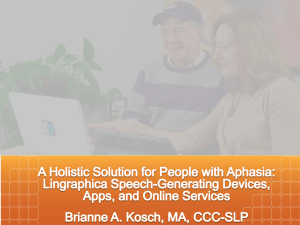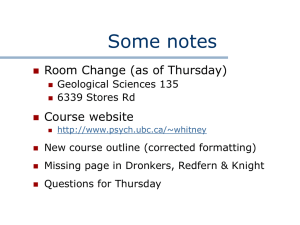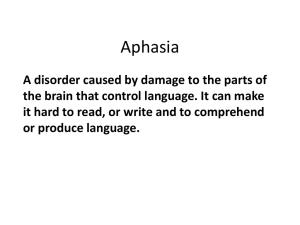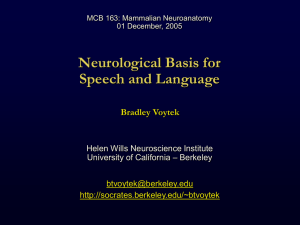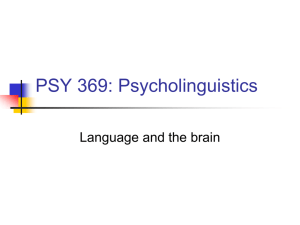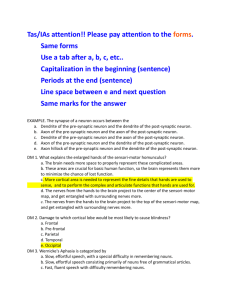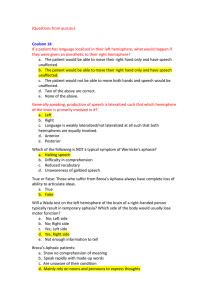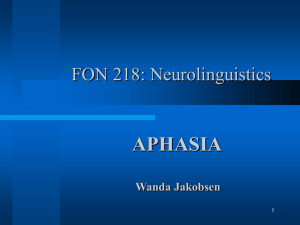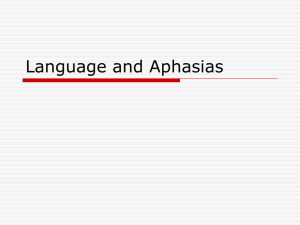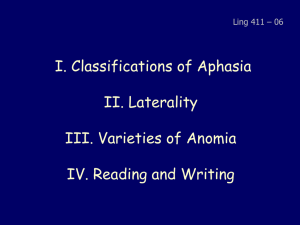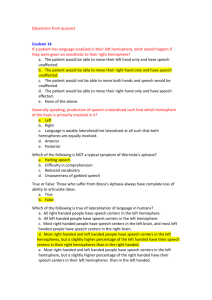Mind/brain dichotomy
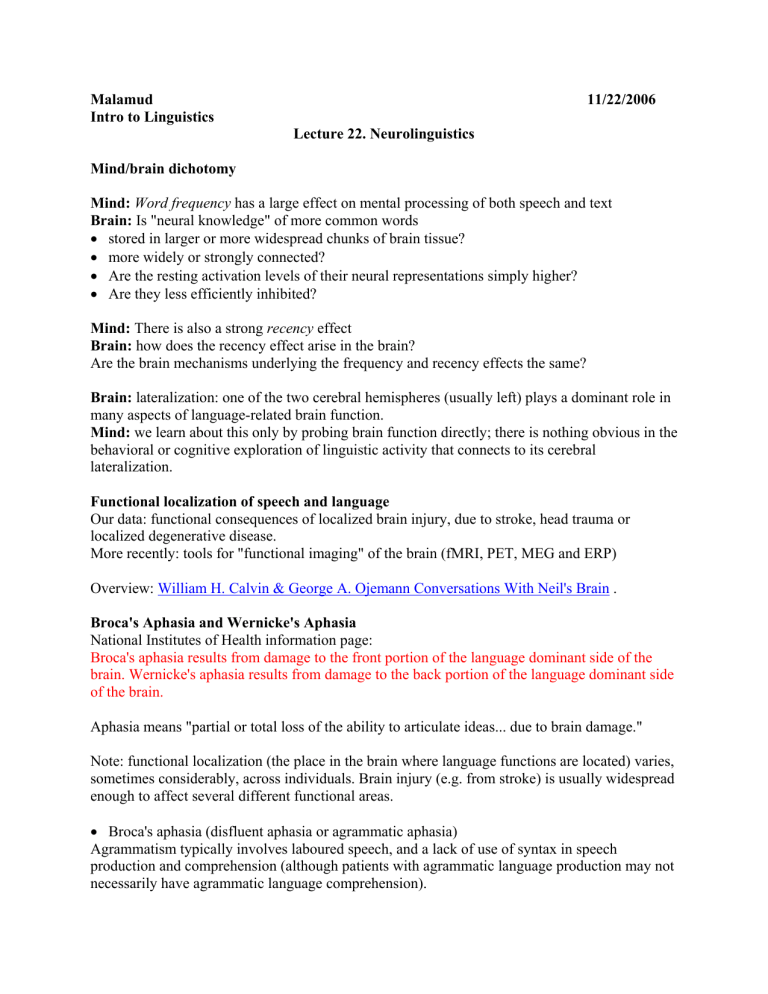
Intro to Linguistics
Lecture 22. Neurolinguistics
Mind/brain dichotomy
Mind: Word frequency has a large effect on mental processing of both speech and text
Brain: Is "neural knowledge" of more common words
• stored in larger or more widespread chunks of brain tissue?
• more widely or strongly connected?
•
Are the resting activation levels of their neural representations simply higher?
•
Are they less efficiently inhibited?
Mind: There is also a strong recency effect
Brain: how does the recency effect arise in the brain?
Are the brain mechanisms underlying the frequency and recency effects the same?
Brain: lateralization: one of the two cerebral hemispheres (usually left) plays a dominant role in many aspects of language-related brain function.
Mind: we learn about this only by probing brain function directly; there is nothing obvious in the behavioral or cognitive exploration of linguistic activity that connects to its cerebral lateralization.
Functional localization of speech and language
Our data: functional consequences of localized brain injury, due to stroke, head trauma or localized degenerative disease.
More recently: tools for "functional imaging" of the brain (fMRI, PET, MEG and ERP)
Overview: William H. Calvin & George A. Ojemann Conversations With Neil's Brain .
Broca's Aphasia and Wernicke's Aphasia
National Institutes of Health information page:
Broca's aphasia results from damage to the front portion of the language dominant side of the brain. Wernicke's aphasia results from damage to the back portion of the language dominant side of the brain.
Aphasia means "partial or total loss of the ability to articulate ideas... due to brain damage."
Note: functional localization (the place in the brain where language functions are located) varies, sometimes considerably, across individuals. Brain injury (e.g. from stroke) is usually widespread enough to affect several different functional areas.
•
Broca's aphasia (disfluent aphasia or agrammatic aphasia)
Agrammatism typically involves laboured speech, and a lack of use of syntax in speech production and comprehension (although patients with agrammatic language production may not necessarily have agrammatic language comprehension).
•
The portion of the motor strip adjacent to Broca's area controls the face and mouth.
Between motor strip & Broca's area: supplementary motor area (SMA) & premotor cortex: generating action sequences from memory that fit into a precise timing plan.
Why do syntactic abilities seem to be localized there?
Maybe: neural architecture for creating & storing complex motor plans has been pressed into service to create & store symbolic rather than purely motoric structures.
•
Wernicke's aphasia ( sensory aphasia or fluent aphasia )
The speech of a Wernicke's patient is often a normally-intoned stream of grammatical markers, pronouns, prepositions, articles and auxiliaries; difficulty in recalling correct content words, especially nouns ( anomia ). The slots where the nouns should go are often filled with meaningless neologisms ( paraphasia ).
•
Wernicke's patients: more disorders of thought; often unaware they don’t make sense
•
Broca's patients: able to reason much as before stroke, unable to speak fluently, unhappy and frustrated with their aphasia
•
Wernicke's area is at the boundary of the temporal and parietal lobes, near the parietal lobe association cortex, where cross-modality integration (the integration of information coming from different senses, e.g. identifying something based on the combination of its visual appearance and its smell) is said to take place, and is adjacent to the auditory association cortex in the temporal lobe.
In typical cases of aphasia, the area of damage is rather large, and a wide variety of functions may be affected to one degree or another.
A more elaborated taxonomy
The table below shows the relationship of 8 named aphasic syndromes to six general types of symptoms:
Fluent Repetition Comprehension Naming
Right-side Sensory hemiplegia deficits
Broca
Wernicke no poor good yes poor poor poor yes poor no few some
Conduction
Global yes poor good no poor poor
Transcortical motor no good good
Transcortical sensory yes Good poor poor no some poor yes yes poor some no poor some yes
Transcortical mixed no Good poor poor some yes
Anomia yes Good good poor no no
Connecting mind and brain? the declarative/procedural model
Declarative memory : facts, like the color of a peach; specialized for learning and processing arbitrarily-related information, and is based in temporal (and temporal/parietal) lobe structures
Procedural memory : skills, like riding a bicycle. specialized for non-conscious learning and control of motor and cognitive skills, which involve chaining of events in time sequence, and is based in frontal/basal-ganglia circuits.
Michael Ullman and his collaborators: "declarative/procedural model":
Lexical knowledge (the association of meaning and sound for morphemes, irregular wordforms and fixed or idiomatic phrases): declarative, temporal-lobe system
Grammatical knowledge (productive methods for real-time sequencing of lexical elements): procedural, frontal/basal-ganglia system.
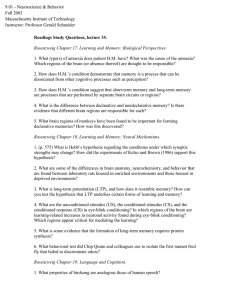
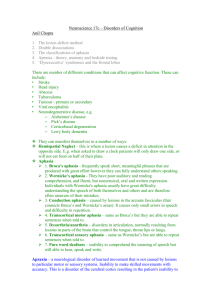
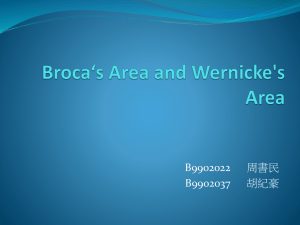

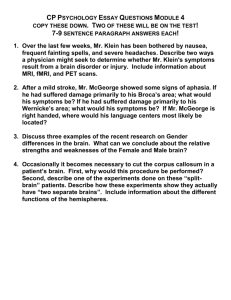
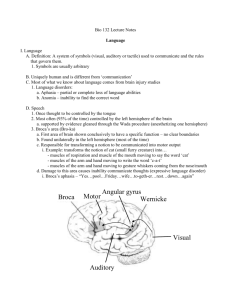
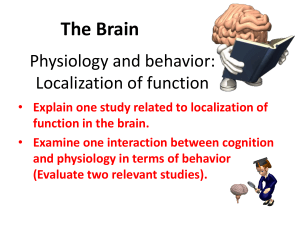
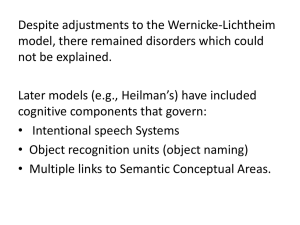
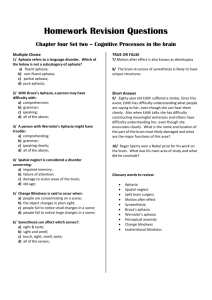
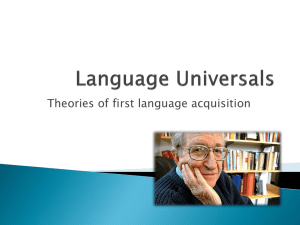
![Wernicke`s_area_presentation[1] (Cipryana Mack)](http://s2.studylib.net/store/data/005312943_1-7f44a63b1f3c5107424c89eb65857143-300x300.png)
